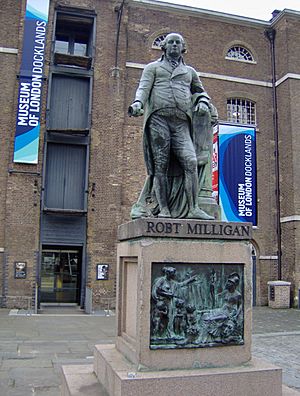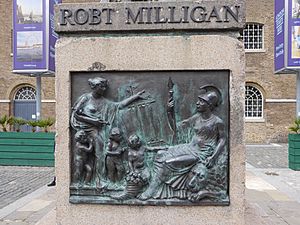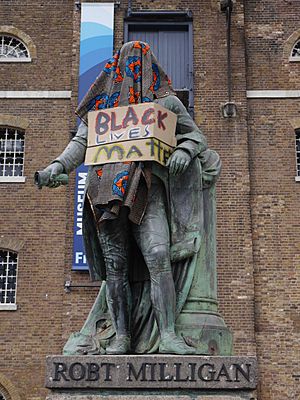Statue of Robert Milligan facts for kids
Quick facts for kids Statue of Robert Milligan |
|
|---|---|

The statue in 2017
|
|
| Artist | Richard Westmacott |
| Location | London, England |
| 51°30′26″N 0°01′26″W / 51.50735°N 0.02389°W | |
A statue of Robert Milligan was placed at the West India Docks in London in 1813. Milligan was a merchant who played a big part in building these docks. He was also involved in the slave trade.
The statue was kept in storage for many years. It was put back up in 1997. However, on June 9, 2020, the statue was removed again. This happened as people started to look closely at statues of people connected to slavery.
Contents
History of the Statue
Robert Milligan (1746–1809) was a well-known Scottish merchant and ship owner. He was the main person who pushed for the building of the West India Docks in London. The company that owned the docks asked the sculptor Richard Westmacott to create the statue in May 1809, after Milligan passed away.
The statue was put up in 1813. It stood near the Hibbert Gate until 1875. Then, it was moved to the North Gate. In 1943, the statue was put into storage. It stayed there until 1997. That year, it was put back in its original spot at the West India Dock. The Museum of London Docklands opened in buildings right behind the statue in 2003.
The Statue and the Isle of Dogs
In 1998, a local newspaper called The Islander wrote about the statue. The article called Milligan "the father of the Isle of Dogs." It said he was a very smart person. He convinced city merchants to build the West India Docks on the Isle of Dogs instead of in Wapping. The article suggested celebrating July 12, 2000. This date marked 200 years since the docks' foundation stone was laid in 1800.
Learning About Slavery in 2007
In 2007, the Museum of London Docklands opened a new part called London, Sugar and Slavery. This new area clearly showed the links between the West India Dock, sugar warehouses, and the forced labor of enslaved Africans.
Around this time, the museum also covered the statue of Robert Milligan with black cloth and rope. This was to highlight his connection to slavery. The museum also asked visitors for their thoughts on the statue. They wanted to know how people felt about Milligan's involvement in the enslavement of Africans.
Removal of the Statue in 2020
After a statue of Edward Colston was removed in Bristol, people started asking for Robert Milligan's statue to be taken down. This happened during protests against racism, following the death of George Floyd.
A petition was started by a local councillor, Ehtasham Haque. It quickly got 4,000 signatures. He said that the statue still being there in 2020 was "an insult to humanity." Protests were planned for the evenings.
Protesters covered the statue with a cloth and put signs on it. On June 9, 2020, the Museum of London Docklands said the statue had become "an object of protest." They believed it should stay that way as long as it was there. The museum also said they thought the statue should be removed. They felt this was right because of its historical links to violence and unfair treatment from the colonial past.
Later that same day, the statue was removed by the local government and the landowners. They did this to "recognise the wishes of the community." The removal happened on the same day that Mayor of London Sadiq Khan announced plans to create a group to look at diversity in public statues.



